
Montag Vormittag verbringen wir noch mal im Büro in Delhi, um die weitere Vorgehensweise zu besprechen.
Anschließend nehmen wir wieder einen Wagen, so dass wir wenigstens ein wenig von Delhi außer Hotel, Büro und Flughafen zu sehen bekommen.
Der Tempel der Bahai, einer toleranten Weltreligion, die 1844 von Baha'u'Ilah im Iran gestiftet wurde, ist leider Montags geschlossen.
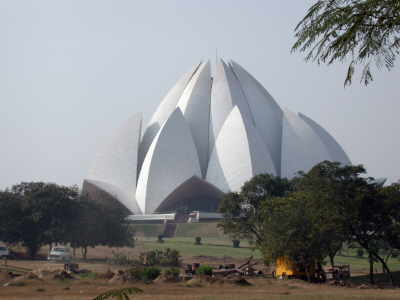
Tempel der Bahai
Humayuns Grabmal, das als architektonischer Vorläufer des Taj Mahal gilt, wurde vor einigen Jahren zum Weltkulturerbe erklärt.
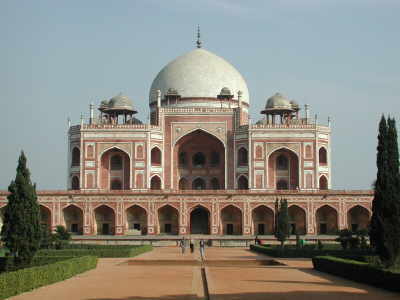
Humayuns Grabmal
Detaillierte Erklärungen zum Grabmal Humayuns sind, seiner Historie und der umliegenden Gräber sind auf verschiedenen Schautafeln in einem der Zugangsgebäude zu finden. Ich habe mir erlaubt, diese Erklärungen zusammen mit einigen weiteren meiner Bilder auf einer gesonderten Seite abzubilden.
Das Qutab Minar ist mit seinen 72,5 m Höhe immer noch der höchste Steinturm Indiens. Sein Bau wurde 1199 von Sultan Qutabuddin initiiert, der auch die umgebende Moschee Quwwat-ul-Islam erbauen ließ.
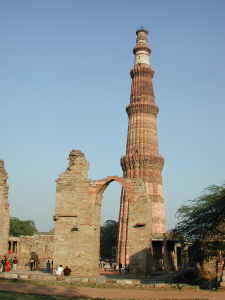
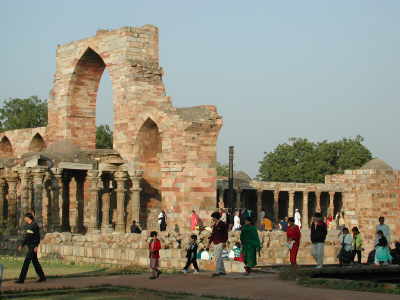
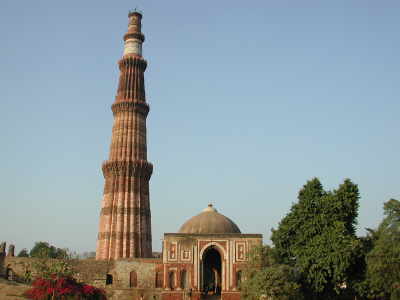
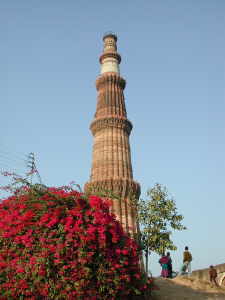
Qutab Minar
Die Lodi-Gärten bilden den Abschluss unserer kurzen Rundfahrt.
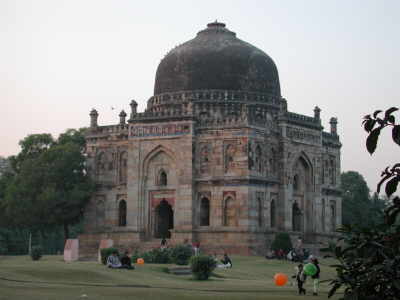
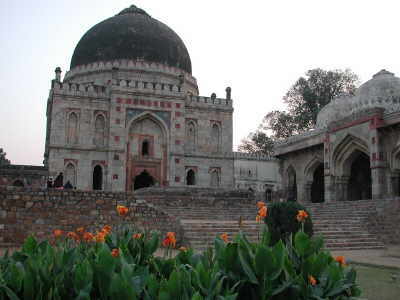
|
Shish-Gumbadi There
exist two patterns in the tomb built during the rule of Lodi sultans
(1451-1526): square and octogonal. This tomb, and the Bara-Gumbad to its
south, are square on plan. With
its facade divided horizontally by a string-course and with series of sunk
niches running above and below it, it has an external semblance of being
double-storeyed. Its westen wall is provided with a Mihrab (arch), which
served as a mosque, while the other sides have a central entrance set in a
projecting frame. The niches are spanned by arches, the central openings
by bracket – and lintel beams, combining thus features of both Hindu and
Islamic architecture. It was originally faced with friezes of blue
enamelled tiles, which survive now only in traces, and which gave it its
name, meaning a dome of glass. Inside,
its high ceiling is decorated with stucco and painted ornamentation
containing floral patterns and quranic inscriptions. There are several
graces inside it, but the names of persons buried here are are not known.
The tomb was, however, built perhaps during Sikandar Lodis reign
(1489-1517).
|
Bara
Gumbad During
the Lodi-Period (1451-1526), tombs were raised in two styles: square and
octagonal. The Bara-Gumbad and the Shish Gumbad to its north are examples
of the square type, while two other tombs in the Lodi gardens represent
the octagonal type. Adjoining
the Bara-Gumbad is a mosque which has led some scholars to surmise that
this structure was raised as a gateway of the mosque. The Bara-Gumbad,
however, is nothing but a tomb with certain unique features. The mosque
was no doubt erected as an adjunct to the tomb, and finally, in front of
the mosque was raised a Mihman-Khana guest house for pilgrims. Like
the Shish Gumbad, the Bara-Gumbad also has a semblance of being
double-storeyed; it combines spans of both arches and bracket-and-lintel
beams: is decorated with stucco and painted ornamentation and is faced in
selected places with red stone to relieve the monotony of the grey surface.
In addition black stone is also used here. The name of the pesonage who was buried in the Bara-Gumbad, but whose grave not longer exists, is not known, but he must have occupied an important position during Skandar Lodi’s reign. Bara-Gumbad
Mosque This
three-domed mosque was built in A.H. 900 (1494) during Sikandar Lodi’s
reign, according to an inscription on its southern interior. The
mosque-hall is faced with five arched openings and a frontage of
bracket-and-chhaja cornice above them the tapering minarets at the rear
are in Tughlaq style but seem to anticipate the octogonal towers of early
Mughal and sur periods. The oriel windows on the north and south also
anticipate features of later mosques. The
interior of the mosque is extremely rich in arabesque stucco decoration
and paintings, consisting of floral and geometric designs and quranic
inscriptions. Partaking both the Tughlaq and Mughal features, it occupies
an important place in the development of the Mughal mosque. The
long hall in front of the mosque was built as a Mihman Khana or guest
house, the tank in the centre of the courtyard appears to have been filled
later and a grave laid there. |
|
Diese Erklärungen sind auf Steintafeln vor den beiden Grab/Moschee-Komplexen zu finden |
|
Gegen Mitternacht checke ich dann aus dem Hotel aus, um meinen Rückflug gegen 3:00 Uhr morgens anzutreten.


